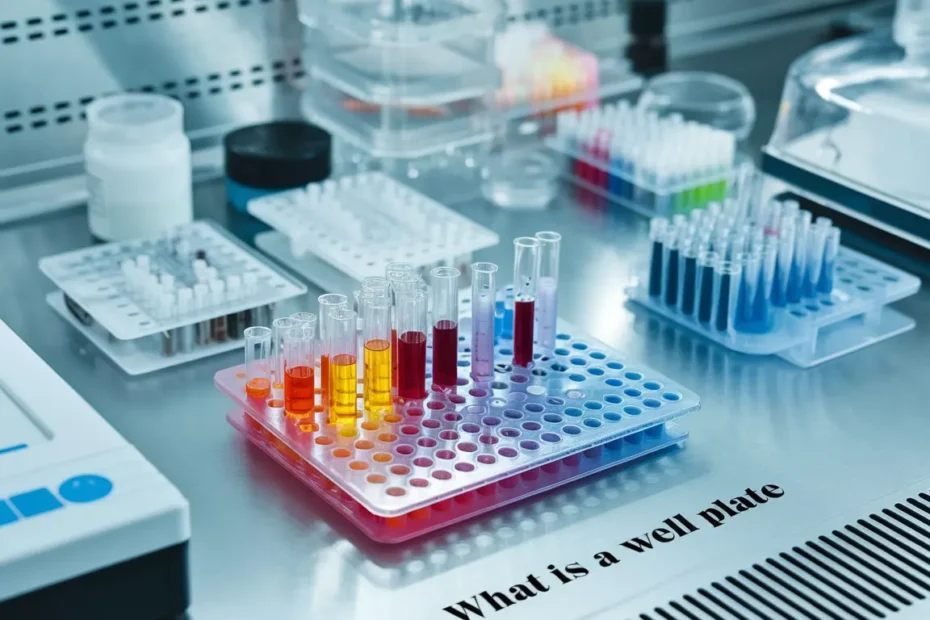What is a Well Plate? A well plate, also known as a microplate or microtiter plate, is an essential tool in laboratories across scientific disciplines, from chemistry and biology to pharmacology and environmental science. It’s a flat plate with multiple wells that serves as a miniature test tube holder, facilitating high-throughput screening and sample analysis.
In this article, we’ll explore the structure, materials, and specific uses of well plates in various applications, giving you a complete understanding of their importance in modern laboratory work.
What is the Structure of a Well Plate?
Well plates come in various sizes, with the most common formats being 96, 384, and 1536 wells. Each well is a small, cylindrical compartment designed to hold minute liquid volumes, typically between a few microliters to several hundred microliters.
Key Features of Well Plate Formats:
- Well Count: Common configurations include 6, 12, 24, 48, 96, 384, and 1536 wells.
- Well Shape: Wells can be round, flat, or conical, each serving different purposes.
- Well Volume: Volumes vary based on the plate’s intended use, ranging from low-volume for sensitive assays to high-volume for cell cultures.
- Material: Made primarily from polystyrene for optical clarity, polypropylene for chemical resistance, and glass for specialized assays.
Types of Well Plates and Their Applications
Different well plates are optimized for specific applications. Here’s a breakdown of common types and where they are most frequently used.
1. Assay Plates
Purpose: Primarily used in biochemical and cell-based assays.
Features: High optical clarity and treated surfaces for cellular adhesion.
Applications: Enzyme-linked immunosorbent assays (ELISA), colorimetric assays, and fluorescent assays.
2. PCR Plates
Purpose: Designed for Polymerase Chain Reaction (PCR), which amplifies DNA samples.
Features: Thin-walled to ensure uniform heat distribution.
Applications: Genetic research, disease detection, and DNA/RNA amplification.
3. Storage Plates
Purpose: Long-term sample storage.
Features: Made from polypropylene for chemical stability.
Applications: Compound storage in drug discovery, sample archiving, and chemical storage.
4. Filtration Plates
Purpose: Allows separation of liquids from solids using a filter.
Features: Integrated filtration membranes.
Applications: Protein purification, DNA extraction, and cell separation.
How are Well Plates Made? Understanding Materials and Production
Well plates are produced using injection molding processes, ensuring precision and uniformity in each well. The choice of material is essential for different applications:
- Polystyrene: Offers high optical clarity, ideal for visual assays.
- Polypropylene: Provides chemical resistance, suitable for storage and chemical applications.
- Glass: Rarely used but ideal for high-precision assays requiring inert, non-reactive surfaces.
Each material’s properties play a crucial role in assay reliability, storage stability, and compatibility with various solvents or reagents.
Why are Well Plates Important? The Advantages of Using Well Plates
Well plates are invaluable in laboratories due to their ability to:
- Enhance Throughput: With hundreds of wells in a single plate, scientists can conduct multiple tests simultaneously.
- Save Resources: Small well volumes reduce reagent use, lowering experiment costs.
- Improve Accuracy and Consistency: Automated systems can quickly load, mix, and read results from well plates, minimizing human error.
Real-World Applications of Well Plates
1. Pharmaceutical Drug Discovery
High-throughput screening in well plates accelerates drug discovery by allowing thousands of chemical compounds to be tested for biological activity.
2. Genomics and Molecular Biology
PCR plates support genetic research, helping scientists amplify DNA for genetic testing, ancestry research, and forensic science.
3. Environmental Testing
Well plates are used to analyze water samples, soil contaminants, and other environmental pollutants, aiding in eco-friendly and accurate testing.
Tips for Choosing the Right Well Plate for Your Experiment
Selecting the appropriate well plate depends on the experiment’s requirements:
- Assay Type: For optical assays, polystyrene well plates are best, while polypropylene is preferred for chemical stability.
- Volume Requirements: Choose well plates with appropriate well volumes to avoid wastage.
- Temperature Needs: PCR plates should be heat-resistant, while storage plates should handle freezer temperatures.
What is a Well Plate Role in Modern Science: From Expert’s Perspective
From drug discovery to environmental science, well plates are indispensable for high-throughput testing and precise analyses. Choosing the right type of well plate and understanding its material and format can greatly enhance your experiment’s reliability and efficiency.
What is a Well Plate: The History of the Well Plate
The development of the well plate began in 1951 with Hungarian scientist Dr. Gyula Takátsy, who created the first microplate by machining six rows of 12 wells into a Lucite block. This initial design was later improved upon by Dr. John Louis Sever, who published the first 96-well plate format in 1962. However, the microplate only gained widespread use in the late 1980s when John Liner introduced a molded plastic version, making it more affordable and accessible for laboratories worldwide. By 1990, over 15 companies were manufacturing various types of microplates to meet the growing demand in scientific research, with an estimated 125 million microplates used in labs by the year 2000.
In the early 1990s, additional trade names for microplates emerged, such as “Viewplate” and “Unifilter,” produced by companies like Polyfiltronics and later sold by Packard Instrument (now part of PerkinElmer). The term “Microtiter” became a registered trademark of Thermo Electron OY, showcasing the expanding importance of microplates in scientific research.
Recognizing the need for standardized microplates across laboratories, the Society for Biomolecular Screening (SBS), later known as the Society for Biomolecular Sciences, initiated efforts in 1996 to establish uniform microplate standards. This led to a set of guidelines published in 2003 by the American National Standards Institute (ANSI), which ensured consistency in well positioning and plate properties, allowing compatibility across instruments and equipment from different suppliers. This standardization became critical for laboratory automation. In 2010, the Society for Biomolecular Sciences merged with the Association for Laboratory Automation (ALA) to form the Society for Laboratory Automation and Screening (SLAS), renaming the microplate standards as ANSI SLAS standards, which continue to guide microplate design and usage worldwide.
Well Plate Templates: Streamlining Experiment Setup and Analysis
In many laboratories, well plate templates are used to organize and streamline the setup of experiments. These templates provide a visual guide to each well’s purpose, helping lab technicians and researchers keep track of sample placement across the plate. This is especially beneficial in high-throughput assays, where hundreds or even thousands of wells need accurate tracking.
Benefits of Using Well Plate Templates:
- Improved Accuracy: Templates reduce the risk of sample mix-ups by clearly marking each well’s position and function.
- Enhanced Efficiency: For repetitive assays, templates save time by providing a ready-made map for sample loading and data recording.
- Data Consistency: A standardized template allows for consistent data logging, making it easier to compare results across different plates or trials.
Well plate templates are often available in digital formats for integration with lab management software or as printable guides for manual setup. This added organization is vital for complex experiments where precise data collection and consistent sample management are crucial.

